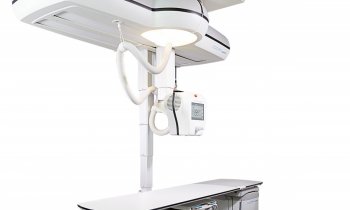Toshiba's 256-row CT
Improved diagnostic possibilities and reduced radiation exposure.
With Toshiba's 256-row CT scanner, Multi-Slice Computed Tomography (MSCT) will make a quantum leap. Consequently, expectations were high when the new CT premiered during “New Horizons” on 18-21 October. And the expectations were more than met. In his presentation, Dr Patrik Rogalla, radiologist at the Charité Berlin, impressively demonstrated the diagnostic potential of the new 256-row CT scanner.

The 256-MSCT prototype system features a 128 mm broad detector, which translates into a major benefit, because of its wide field of anatomical coverage. In cardiac diagnostics, the entire heart can be scanned in just one single rotation. “Traditional” CT scanners require a helical scan, with multiple rotations, in order to cover the entire heart. This procedure will be no longer necessary with a 256-MSCT scanner. ‘The crucial aspect of this new technology is the fact that radiation exposure is considerably reduced. A single rotation cardiac scan with a 256-MSCT requires a dose of just 1 to 2 mSv, compared to 10 –20 mSv in Helical CT scanners,’ Dr Rogalla explains. Supposing rotation time of 400 ms, the temporal resolution can be between 200 ms to 67 msec, by just adding 1 or 2 rotations, therefore leaving the dose considerably below a traditional MSCT. Even with erratic heart rates the 256–MSCT can provide a precise diagnostic accuracy in visualising the right and left coronary arterial system.
Dr Rogalla is not only impressed by the enhanced cardiac functionalities, he also expects entirely new possibilities to image organs: ‘Up to now, whole-organ imaging has been very limited. With this new technology we hope to be able to visualise not only morphology but also perfusion and maybe also organ function. The combination of morphology, 3D and perfusion imaging has an immense potential, for example we could detect the effects of pathological changes or ventilation.’
In the future, CT may assume a more important role in functional diagnostics, currently the domain of MRI. These two procedures, says Dr Rogalla, have in the past positively influenced each other. And, just like experience gained with CT, are being applied to MRI diagnostics, the new CT technology may well profit from MRI knowledge.
The diagnostic advantages of the 256-row scanner are obvious – even though the real potential of this new technology is not yet known, much less exploited. It goes without saying that all procedures that can be performed with a 64-row scanner may also be performed with the new 256-row scanner. The new system provides identical image quality and identical results with regard to high and low contrast.
‘Sensible approach’
New technologies are not always welcomed enthusiastically – particularly not by office-based radiologists. European Hospital asked Dr Patrik Rogalla – CT specialist and daily CT user in a university environment – about the future prospects of the new 256-row technology.
Patrik Rogalla: ‘Many physicians are reluctant to take up path-breaking technologies, above all because they require additional training, protocols change and costs increase. As a radiologist, I fully understand this reservation, as many an innovation is being touted as revolutionary and in the end it can’t deliver on its promise as it is conceptually flawed. In medical science, real innovations happen about every five years.
As far as the 256-row scanner is concerned, there is a cautious and therefore sensible approach: Initially, one can work with the 256-row scanner just like with any previous equipment – and achieve the same high-quality results. That is extremely important in radiological practice. But this new technology holds immense potential and some of the enhancements and advantages are already visible (see article). We are curious what the future will bring!’
17.11.2006











